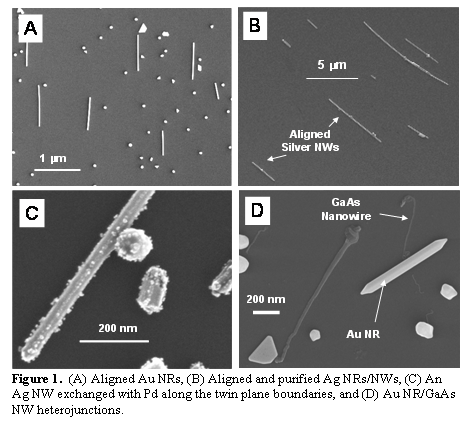
ACS PRF | ACS
All e-Annual Reports

42680-G10
Direct Observation of Gold Nanoparticle 'Seeds' Growing into Gold Nanorods and the Formation of Patterned Gold Nanorod Assemblies
Prior to receiving this grant, our group demonstrated the synthesis of one-dimensional (1D) Au nanorods (NRs) directly on surfaces with control over their aspect ratio and we showed that these rods could be manipulated and broke with an AFM tip. The goals of our proposal were to 1) improve control over the size, shape, and yield of NRs on the surface, 2) determine the effect of seed crystallinity on the shape of the nanostructure, 3) grow the NRs in well-defined patterns, 4) grow well-aligned NRs, and 5) put all of the knowledge together to prepare highly-aligned, patterned NRs with high yield and controlled size and shape. We have not fully achieved the final goal, but have made significant advancements. Before learning our grant was awarded by ACS, we closely monitored the growth of individual seed particles growing into Au NRs by atomic force microscopy (AFM), demonstrated patterning of Au NRs directly on surfaces, and developed a method for purifying the surface-grown Au NRs. These studies provided us with new insight into the Au NR growth process and allowed us to assemble these interesting nanomaterials on surfaces. We also demonstrated a method for growing Au NRs directly on surface-attached single-wall carbon nanotubes to fabricate interesting Au NR/SWCNT heterojunctions that could be useful in nanoscale electronic devices.
Since receiving the grant, we successfully demonstrated the growth of highly aligned Au NRs directly on surfaces, which was one of our original goals of the proposal. In our original procedure, Au NRs grown directly on glass and silicon from gold “seed” particles were randomly oriented. To grow aligned rods, we simply altered the surface chemistry, which results in a lower density of NRs on the surface and, more importantly, parallel alignment of the NRs on the surface (Figure 1A). Greater than 80% of the rods align in the same direction. Interestingly, we found that the alignment direction rotates throughout the sample. We are currently working on experiments to better understand the alignment mechanism and better control it. Alignment is important for utilizing orientation-dependent optical properties and for plasmonics applications.
We recently extended the seed-mediated growth procedure for growing Au NRs on surfaces to the growth of Ag NRs. The growth is pH-dependent and leads to Ag NRs/NWs in lower yield, but with much higher aspect ratio compared to Au. We discovered the optimal pH for growth, purified the NRs/NWs by selectively removing other shapes with adhesive tape, and used the same alignment procedure for Au to align Ag. Figure 1B shows an SEM image of a purified and aligned Ag NR/NW sample. To extend the composition of the structures further, we converted surface grown Ag NRs/NWs into Pd and Pt through galvanic-exchange reactions. These structures are tubular and porous, making them ideal for catalytic and sensing applications. We have been studying the morphology of the galvanic-exchanged nanostructures as a function of time for different reaction rates to better control the morphology and obtain unique structures. Figure 1C shows the initial stages of galvanic exchange of Pd on Ag, where the twin plane edges of the Ag NR are preferentially decorated with Pd nanoparticles. This work is important for extending our procedures to a wider range of metals and for designing new pure or bimetallic structures through kinetically-controlled galvanic exchange. The materials have promise in catalysis and sensing applications.
Using funds from this grant, we fabricated various 1D nanoscale heterojunctions directly on surfaces using the combination of self-assembly, seed-mediated growth and vapor deposition methods. We specifically synthesized 1D AuNR/GaAs and GaAs/SWCNT heterojunctions directly on surfaces. Figure 1D shows and example of an AuNR/GaAs heterojunction synthesized directly on silicon by first growing GaAs by chemical vapor deposition, using Au nanoparticles as a catalyst, and then growing Au NRs from the Au catalyst by seed-mediated growth. We synthesized these structures and will be characterizing the electronic properties in collaboration with Professor Sumanasekera in the Physics Department here at the
The ACS-PRF also supported a supplemental award to this grant, which was used to support a minority undergraduate researcher for summer 2006. The undergraduate performed research throughout the summer on the synthesis of metal NRs directly on surfaces and used these as templates to prepare hollow silica tubes on surfaces. He learned a great deal and advanced the project tremendously. Specifically, he determined the optimal conditions for the synthesis of the template material and removal of the interior metal structure and performed thorough characterization by UV-vis, AFM, electrochemistry, FTIR, and electron microscopy. The experience was rewarding for the undergraduate and our group.
Figure 1. (A) Aligned Au NRs, (B) Aligned and purified Ag NRs/NWs, (C) An Ag NW exchanged with Pd along the twin plane boundaries, and (D) Au NR/GaAs NW heterojunctions. |
